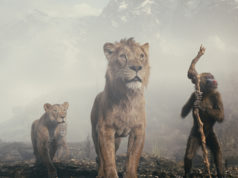First of all, Outlander has nothing to do with Highlander. It’s the sort of movie that reminds you that the line can be very fine between inspired creative lunacy and a really stupid idea. This overlong swords-sandals-and-space-aliens piece that features laughs in all the wrong places falls on the “stupid” side.
The premise is almost bad enough to be good. A space alien who calls himself Kainan (James Caviezel) crash-lands on Earth in medieval Norway, where the Viking villagers are busy chopping each other’s heads off, rolling around in filth, and talking to each other in working-class British accents. An extraterrestrial with the great good fortune of already resembling a human in appearance, Kainan uses an alien gadget to upload knowledge of earthly biology and the local language and customs instantly into his brain. This is a lame device (a lame storytelling device – the actual machine would probably be pretty useful), but it does save Kainan and us the trouble of undergoing laborious scenes where he has to learn how humans relate to each other.
It’s not enough to keep him from getting captured by one of the villages, whose inhabitants are plenty suspicious of the shipwrecked foreigner. Worse is to come, though, because Kainan has unwittingly brought with him a large creature (which he calls a “dragon” for the benefit of the Vikings) that’s now lurking in the woods, making nightly forays into the villages to eat people. It’s up to the alien, aided by the village chief (John Hurt) and his comely daughter (Sophia Myles), to save the people from this threat from outer space. Basically, this is like the current remake of The Day the Earth Stood Still, only with less preaching about the environment.
The film is by director Howard McCain and co-writer Dirk Blackman, the same team that also did the script for Underworld: Rise of the Lycans, which is opening in theaters this weekend alongside Outlander. McCain and Blackman have come up with a story worthy of a gleefully subversive genre parody, yet their script doesn’t contain a single intentional laugh and the overall tone is rather morose. The look of the picture is identical to many other cheap-ass Hollywood medieval flicks: The nighttime scenes are all drowned in blue light, while the daytime scenes are all peasants wearing drab clothes walking past brown vegetation.
The monster is the exception. When we finally see it, it’s a reptilian creature that bioluminesces different colors from its tail and under its skin. This is actually interesting to look at, though it’s nowhere close to making up for the story’s derivative touches. The supporting character’s names are cribbed directly from Beowulf and The Lord of the Rings, and the creature’s habit of storing up dead bodies in its lair for eating recalls The Host and The Descent, two vastly superior monster movies.
Allow me one more unflattering comparison: If you want a sci-fi monster movie crossed with a period piece, there was a pretty good French film six years ago called Brotherhood of the Wolf. That movie had terrific action sequences, an intriguing look, and just enough of a warped sensibility to make its story seem believable. This one, well, it’s about as credible as you’d expect from the story of an alien leading Vikings into battle.











